Right now we do not understand the vast majority of stuff that is out in space. Much of it seems to be invisible, and it is not part of our current understanding of physics. We also do not know how the cosmos began: what made it start growing? What happened at the very beginning? Alongside just the goal of trying to understand its life and its extent, we are still left with some big unknowns.
The origins of the universe
Professor of physics and astrophysical sciences
- The universe is roughly 14 billion years old, with just 5% being ordinary matter and the rest dark components we still do not understand.
- General relativity shows how mass curves space-time, letting gravity shape galaxies, stars and planets.
- When atoms formed 380,000 years after the Big Bang, light finally streamed freely, leaving the cosmic microwave background whose tiny ripples became today’s structures.
- The Big Bang was uniform expansion everywhere, not an explosion from a point, so the universe has no center.
Big unknowns
I am trying to understand the universe as a whole thing, and as part of that, there are some really big outstanding questions that we do not understand, at the same time as having made amazing progress in having an idea of the universe as a whole.
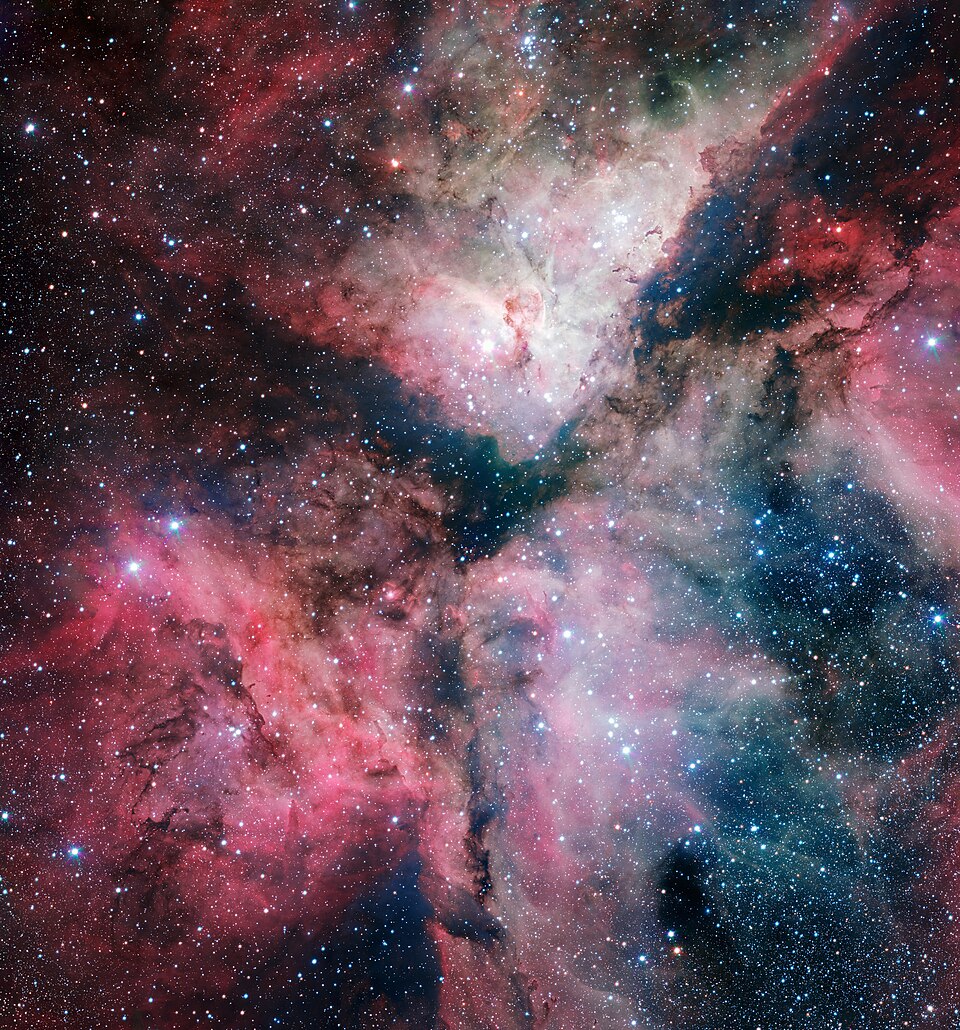 The spectacular star-forming Carina Nebula imaged by the VLT Survey Telescope © ESO
The spectacular star-forming Carina Nebula imaged by the VLT Survey Telescope © ESO
Standard cosmological model
We do have this incredible understanding of the universe. We have this model now. It is a cosmological model that has been around for at least 20 years, and it says that the universe is about 14 billion years old, or at least that it began to grow from what we call the Big Bang 14 billion years ago.
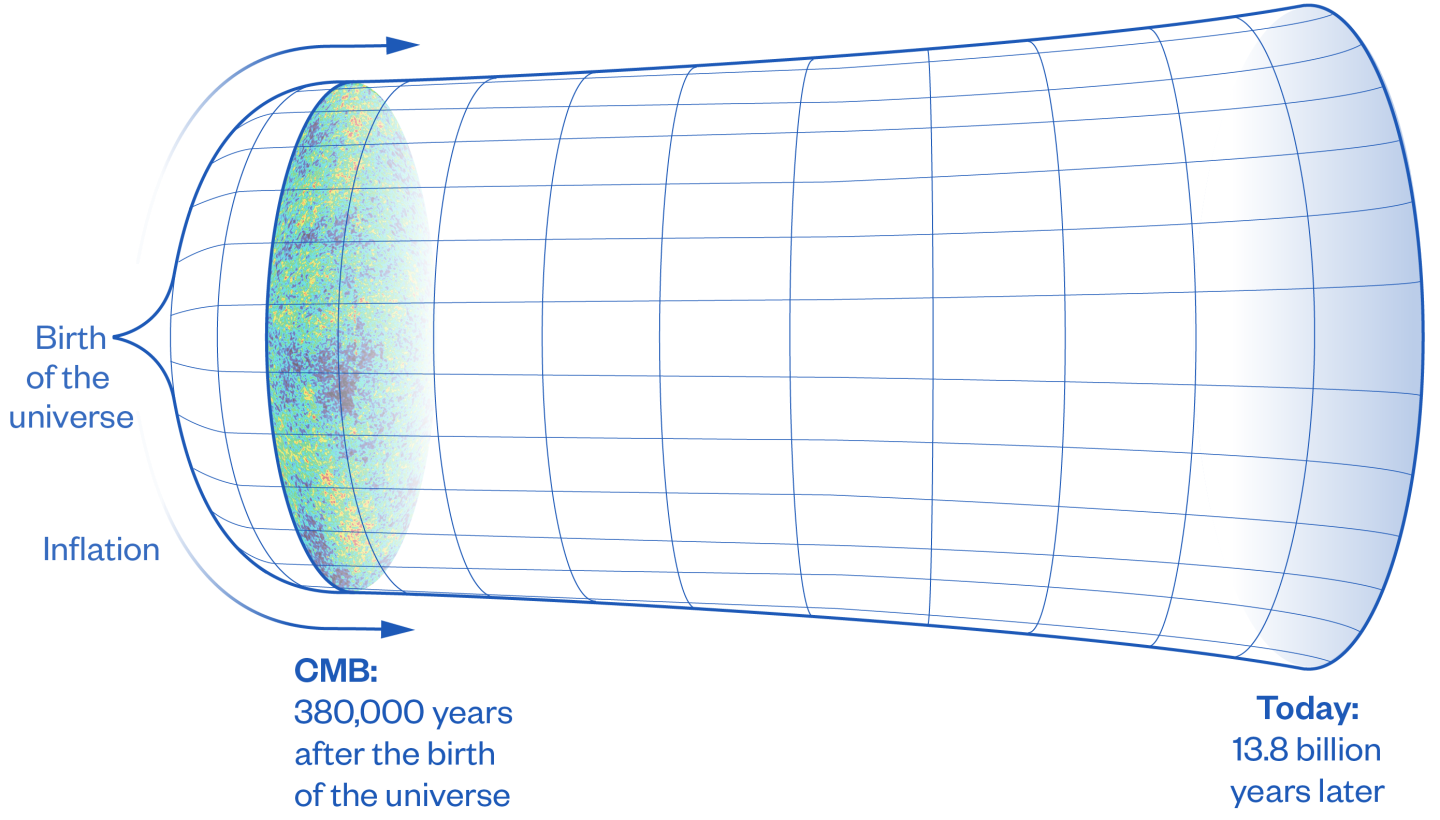 © Lucy Reading Ikkanda, Simons Foundation
© Lucy Reading Ikkanda, Simons Foundation
The idea is it is a growing universe; space has been growing. It started off in a very hot state without any galaxies or stars, just particles. It started expanding, and over millions of years galaxies began to form, and within them stars. Those galaxies merged together over the next billions of years, and one of those galaxies ended up being our Milky Way galaxy, our home. Inside there, over time, the solar system formed, which is our nearest home. We can sort of follow that. We think we have this picture of the universe growing. It follows very simple laws of physics, follows Einstein's gravity, and it has rather simple contents — simple, yet not fully understood. We think we have a good estimate that about 5% of the universe, in terms of mass or energy, is the regular atoms and particles that we know of, but again, the remaining 95% is not fully understood. We can account for it as invisible matter, called cold dark matter, and something that we often refer to as vacuum energy or dark energy that seems to be aiding the expansion of space. What is really remarkable to us as cosmologists and physicists is that we can put into our computers, into our theoretical models, a very simple initial setup of the universe 14 billion years ago, put in those ingredients and let it evolve, and the predictions of what the universe should look like today really match very well what we observe. It is pretty remarkable that we have a rather simple model that does actually match nearly all of the data.
Gravity and relativity
If I were to explain this, simple physics, it is really an extension of Newtonian physics that we experience in our daily life. I drop a ball; it falls to the ground. We, on Earth, orbit the Sun because the Sun's gravity pulls the Earth into orbit around it. The dominant force that governs the evolution of the universe is gravity. The subtlety is that Einstein showed us 100 years ago that Newtonian gravity was not quite enough. It was not quite a good enough description of how things really move in space, and this becomes particularly obvious when you have very heavy objects.
 Art Concept of Earth and Moon on a gravity grid. © Angel Soler Gollonet via Shutterstock
Art Concept of Earth and Moon on a gravity grid. © Angel Soler Gollonet via Shutterstock
Einstein's gravity was a refinement or an enhancement of our understanding; it told us how space responds to having massive stuff in it. If you have a huge object in space, it deforms space and makes other objects move in a way that follows that deformed space. Einstein's general relativity, his law of gravity, is the underpinning law that has the biggest impact on the large-scale universe.
Building on past discoveries
Everything that we do in astronomy and cosmology builds on this tradition of work that began a long time ago, particularly work from about 100 years ago with Einstein's understanding of gravity and the first realizations of the extent of the universe and the fact that it was growing.
 © Shutterstock
© Shutterstock
Until about 100 years ago, astronomers did not know that there was anything outside our Milky Way or indeed that the universe was really changing with time, and that transition of understanding transformed the way we think about the universe and do cosmology. Since then the advances have been both observational and theoretical. We also build on an enormous amount of observations; telescopes have improved our ability to see different kinds of light that we cannot see with our eyes, and we can now see the universe in different ways. At the same time, people have developed a theoretical understanding of the universe. Over the last 50 years, that theoretical underpinning has really guided us. We are part of a long effort and a big team effort in this field.
Advances in telescope technology
Our observations have improved so much in astronomy over the previous decades and are improving right now with great rapidity. There are a few things we want in telescopes. You want to have great sensitivity to pick up light. We are only able to do astronomy because we pick up signals from space that have been traveling to us.
 © Shutterstock
© Shutterstock
Until quite recently, that was mostly light — it was the only thing we could pick up. Now that has changed a little; there are also other signals like gravitational waves — but let's go back to light. Your ability to do astronomy is limited by how well you can measure light from distant objects. You want to do two things: pick up a very small, subtle signal (for example, if you are looking at a distant galaxy that you cannot see with the naked eye, you want a telescope with sensitive detectors, a sensitive camera), and you want to see something in high definition. For something very tiny, you want a telescope with a big collecting dish, a large diameter to collect the light and enhance its resolution. The largest telescopes have things like eight-meter-diameter mirrors; those are in Hawaii and Chile. You also want to be in a place on Earth where the air is very still, so you can see through the atmosphere to the heavens, or you want to be in space on a space telescope.
Benefits of space telescopes
One significant enhancement in the past decades is our ability to put telescopes in space, where the conditions are best of all. You are not limited by having to see through the atmosphere; you can go out into space and look from there, where it is much calmer and clearer.
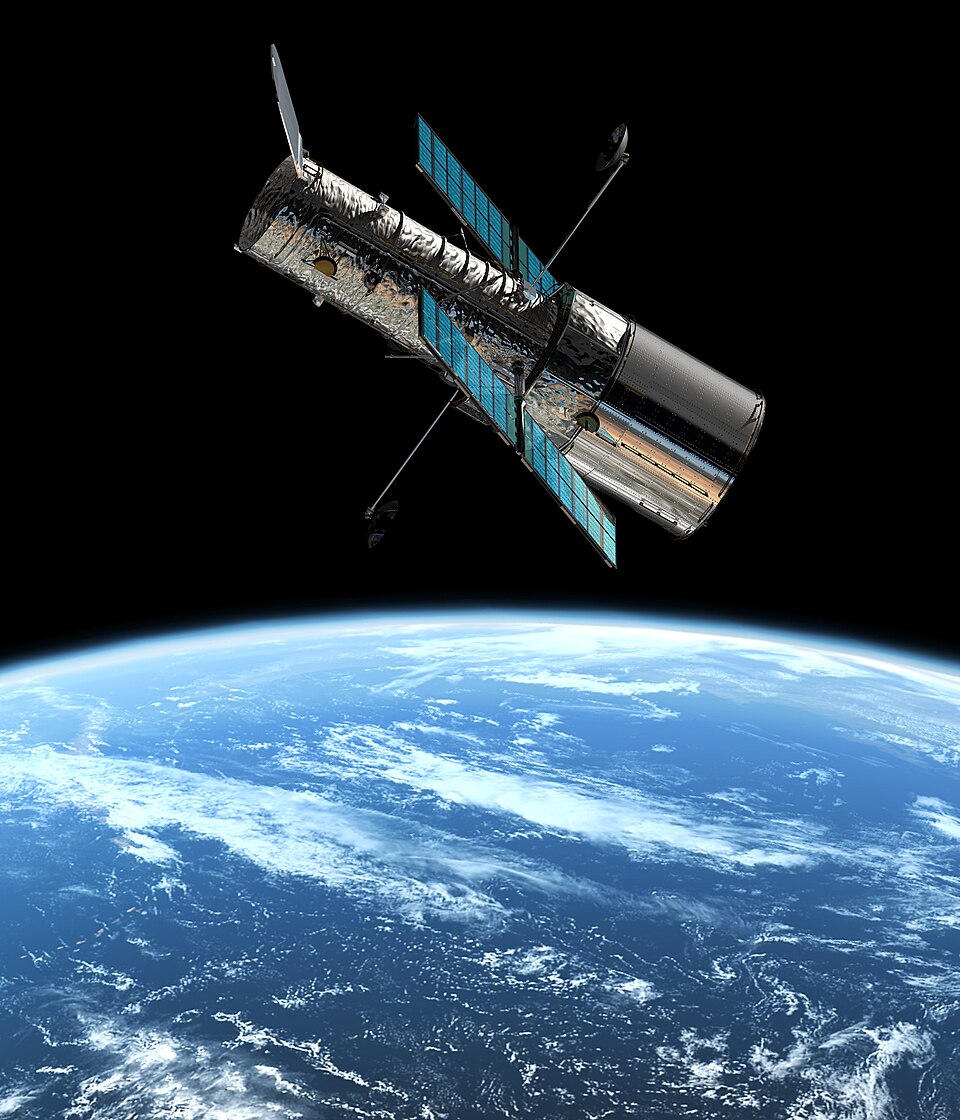 The Hubble Space Telescope in orbit © Hubble ESA
The Hubble Space Telescope in orbit © Hubble ESA
The ability to look in many wavelengths has been a huge advance, too. Our eyes can see visible light, but that is only a tiny portion of the whole electromagnetic spectrum — the whole array of light that is out there — spanning from radio waves through microwaves, visible light, infrared light, and then ultraviolet light, gamma rays and X-rays. We now have telescopes that can look in all those different wavelengths and see this richness that you just could not see with an optical telescope or with your eyes.
Back to the Big Bang
If we are to go back to the Big Bang, or as close to that as we can get, we think we would find ourselves at a moment a fraction of a second after the beginning of time. I say that because we actually do not know. We cannot get back to time zero exactly.
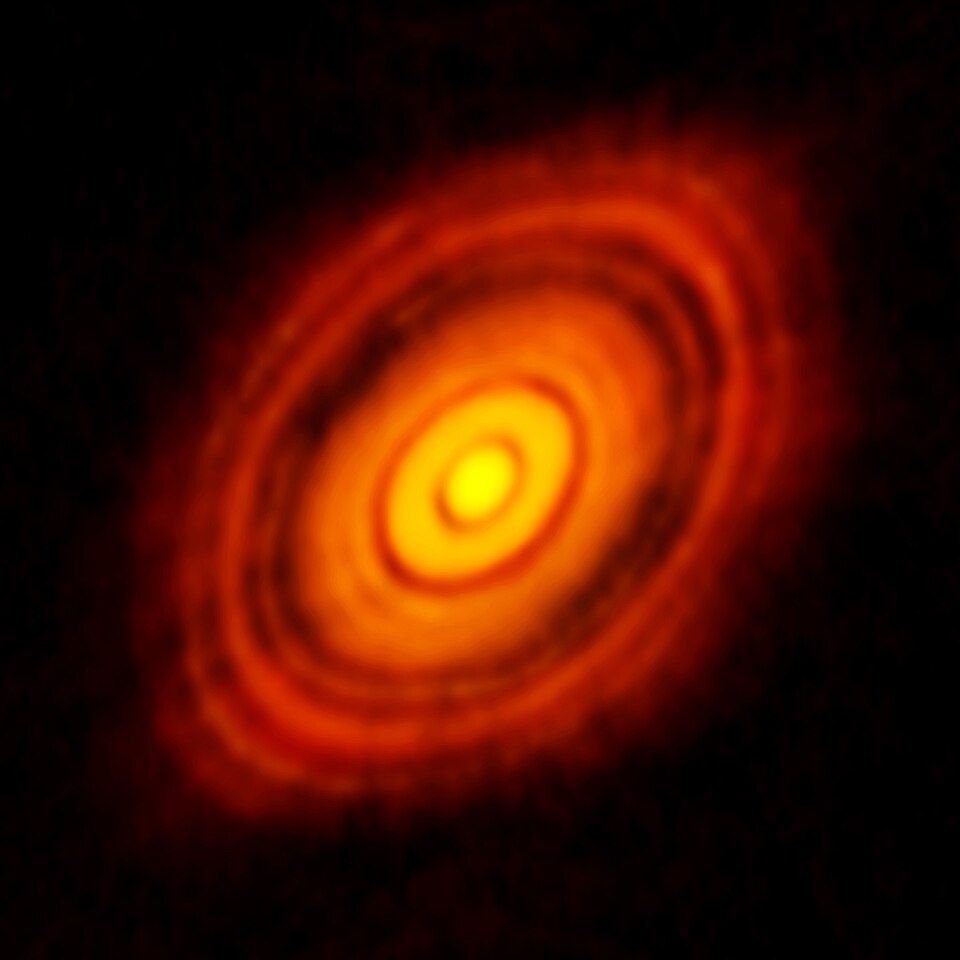 HL Tau protoplanetary disk © ALMA (ESO/NAOJ/NRAO)
HL Tau protoplanetary disk © ALMA (ESO/NAOJ/NRAO)
Something began the expansion of the universe, and if we could go back to that time, we do not think there were any particles yet — certainly no stars, galaxies or planets, and not even any of the particles we know. Some current, popular ideas suggest that perhaps there was just a field of energy back then, often called the inflaton field, something whose potential energy drove a very rapid initial expansion. I will say that we have not definitively shown that this is true, but it is probably the most popular idea.
Particles and light
Very briefly, for a fraction of a second, the energy stored in that field expanded the universe incredibly fast, and then shortly after, it would have decayed, turning into particles and light that we are more familiar with. Let's think about that. We would find ourselves still in the very earliest moments of the universe, but now we would have actual particles and light that we know of. What would it look like?
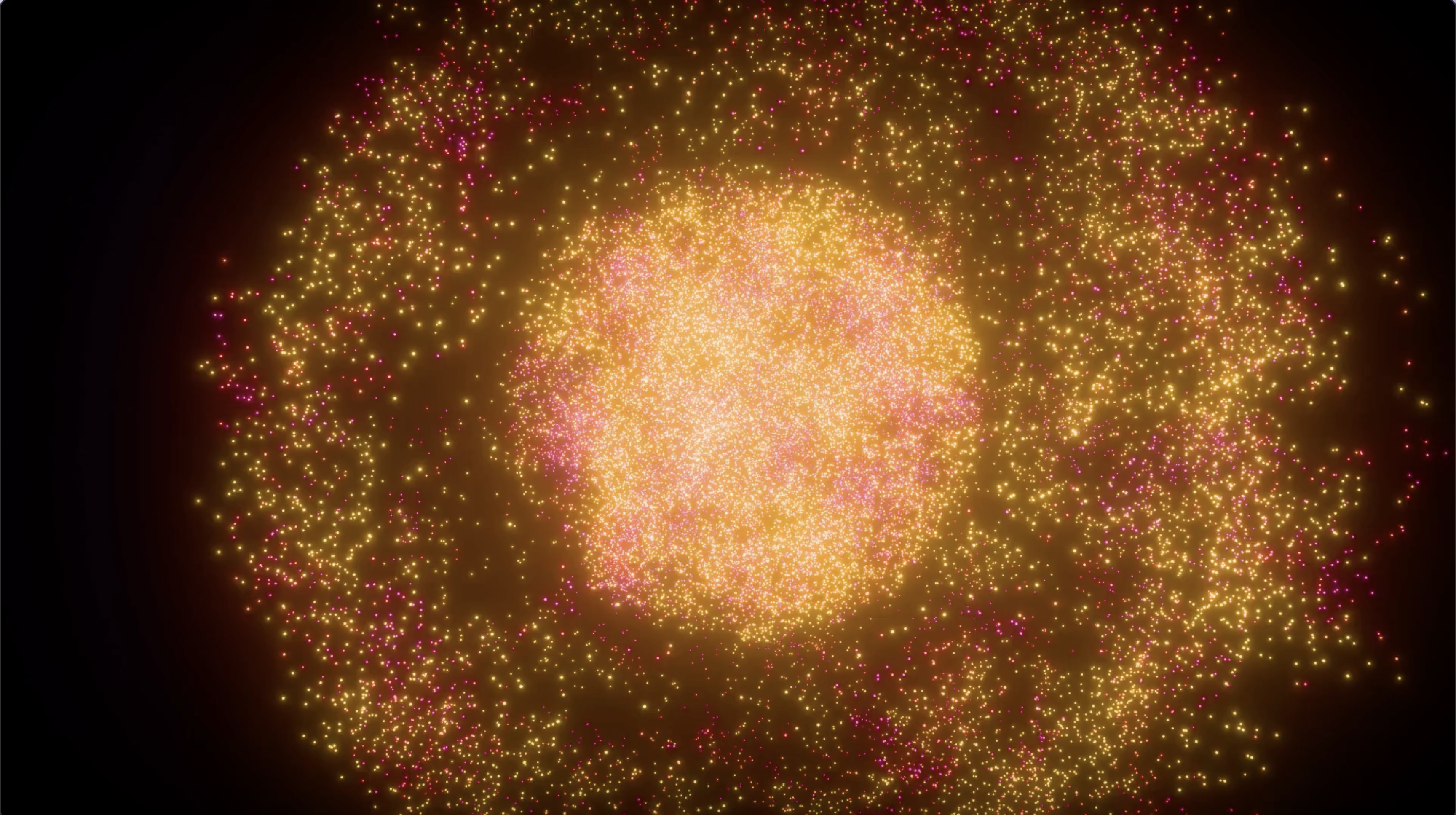 © Pexels
© Pexels
It would have been an almost uniform and quite condensed sea of particles and rays of light, but it would not have been completely uniform. This is critical for our own existence: there would have been slight irregularities in the density of space, and we think those were potentially put in as quantum fluctuations during the initial inflationary expansion, if indeed this is what happened. We find ourselves with this almost uniform sea of particles and light, with tiny overdense and underdense regions, and those are the conditions for the beginning of the growth of everything that comes later.
Opaque early universe
Let's think about that light. In the first few hundred thousand years, the universe was so hot, because it was so compressed, that the particles were broken up into their nuclei and the electrons around them. The ingredients of the universe after a short time were just hydrogen and helium, and we think some invisible dark matter. Let's think about the atoms: they were hydrogen and helium. A hydrogen atom has a proton and an electron. They are usually bound together in a neutral atom, but if the universe is really hot, the energy of the universe and light can break up those parts of the hydrogen atoms, and the proton is separated from the electron.
 The Milky Way and a closeup of the Orion Nebula ©ACT Collaboration
The Milky Way and a closeup of the Orion Nebula ©ACT Collaboration
We think for about 400,000 years we had this plasma, basically an ionized plasma of particles. If a ray of light is around in that universe at that time, it will scatter off the electrons in that plasma, and a ray of light will travel for a bit, scatter off an electron and change direction. It will keep changing directions, and that behavior makes the early universe opaque, a little like a cloud. You cannot see through a cloud because you want the light to travel in a straight path to your eyes or through a medium to see it clearly.
Free rays of light
For the first 400,000 years of the universe's life, it was opaque, a little like living in a cloud, and we cannot see back into that time. A remarkable thing happened when the universe was 380,000 years old — when that amount of time had passed since it started growing — the temperature of the universe became cool enough that the atoms could stay neutral. They were no longer broken up into their components, and from that moment on rays of light that had been scattering off these electrons could travel freely through space.
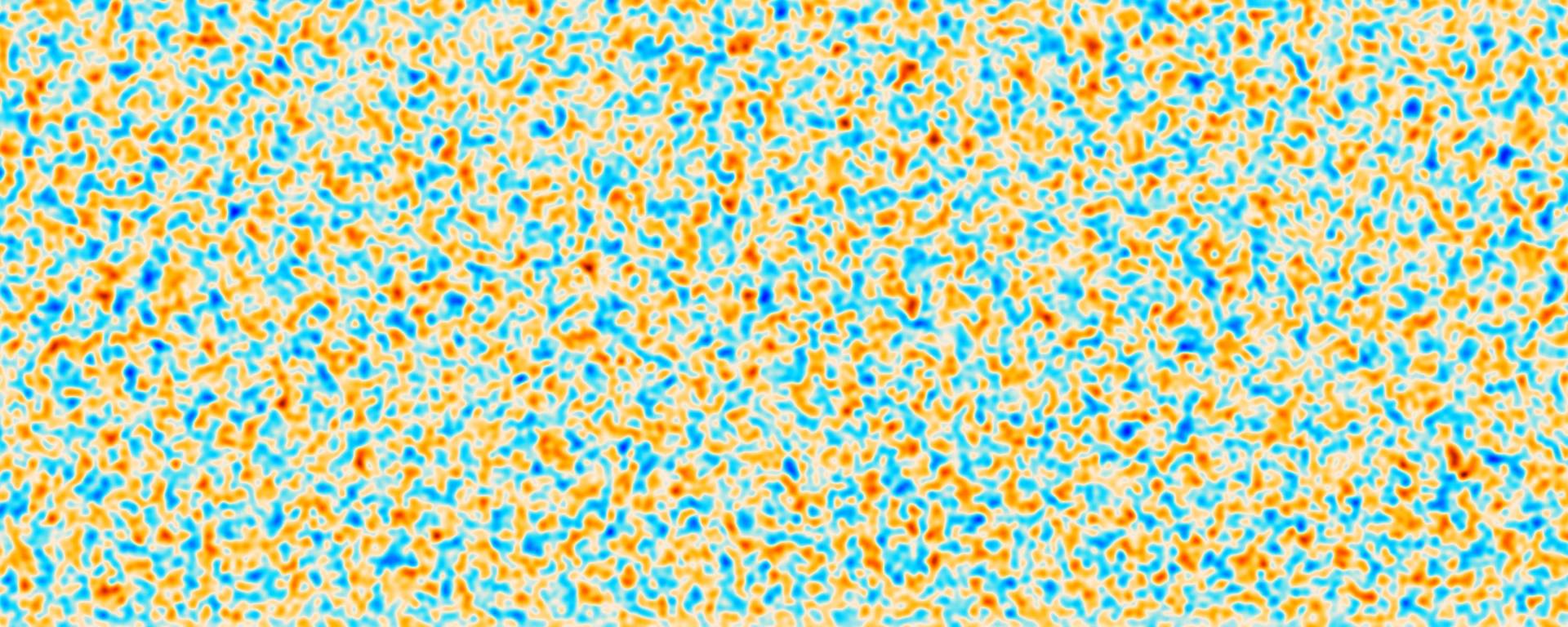 The oldest light in the universe © ACT Collaboration
The oldest light in the universe © ACT Collaboration
They have been traveling through space since then. For 14 billion years of history, they have been traveling through space, and these are the ones we can capture now. They bring us an image of what the universe was like back then, and we capture this particular moment in time, back at that point in the universe, and it is the very earliest time that we can see.
The seeds of us
We see this light now; we capture it, and the most recent image of it taken over the whole sky is from the Planck satellite.
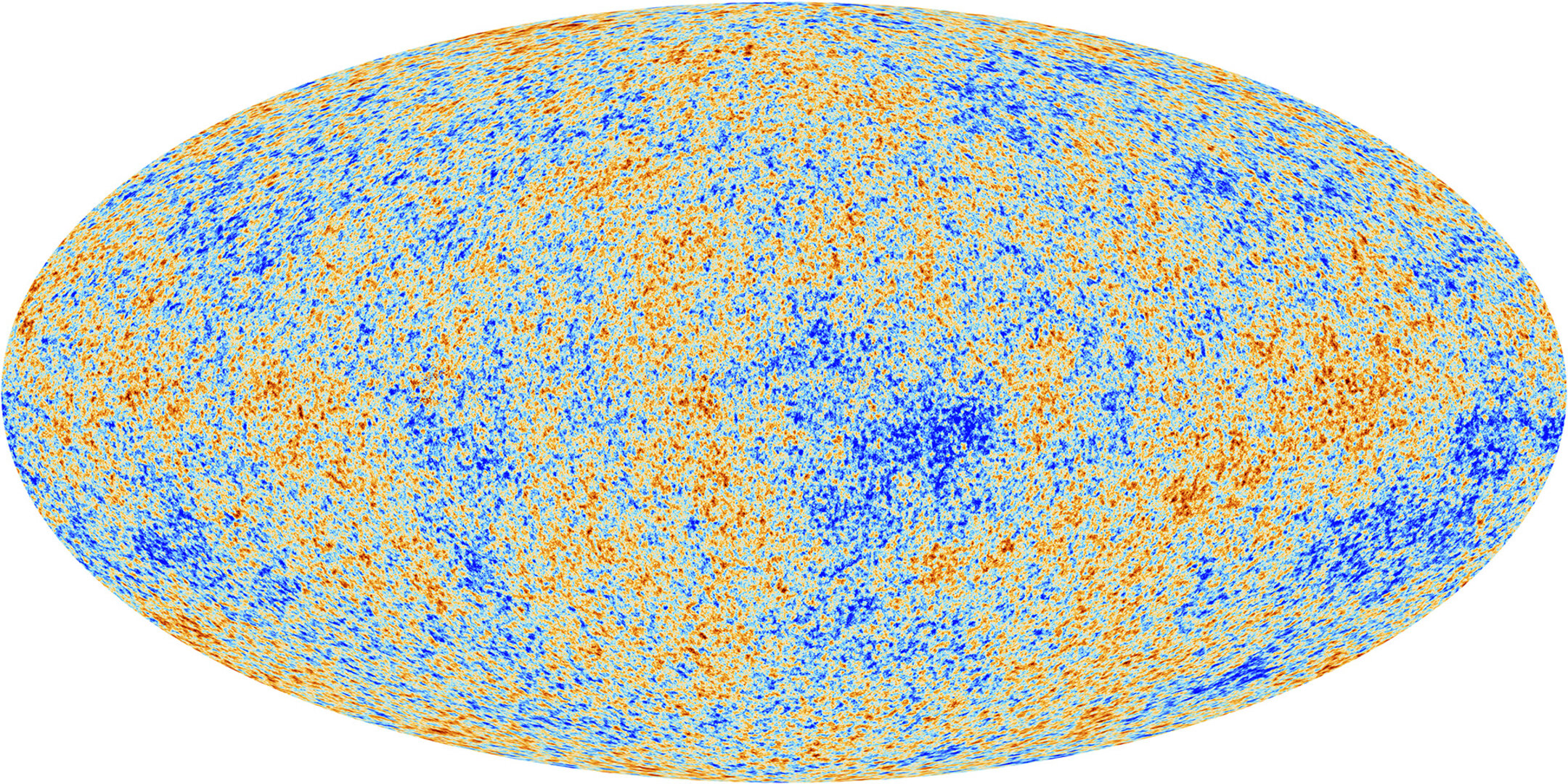 The anisotropies of the Cosmic microwave background (CMB) as observed by Planck. © ESA and the Planck collaboration
The anisotropies of the Cosmic microwave background (CMB) as observed by Planck. © ESA and the Planck collaboration
The image looks like an oval, but it is really an image of the sphere around us that is just unwrapped onto an oval for viewing on the screen. The blue and red blobs, or spots, capture the intensity of the light coming from that time in the early universe's history. Those variations look quite enhanced — you see strong red and strong blue spots — but they are actually subtle variations around an average intensity. On average, this light that reaches us now has the same intensity everywhere, and it has been stretched into the millimeter wavelength. Its effective temperature is –270 degrees; it is three degrees above absolute zero. It is very, very faint, and the variations are on the order of one part in a million around that.
Coping with cosmic timescales
We have this enormous time scale that we are thinking about when we consider the universe — 14 billion years — and our solar system has been around for about five billion years of that. We think we are halfway through the Sun's regular life cycle, and those are huge numbers. They are much bigger numbers than we deal with in daily life, where we might live for only a number of decades, and the time scales we care about are hours and minutes. As a cosmologist, I try not to think of it all at once, both in terms of scale in space and in time. I find it helpful to think about it in relative terms.
 Nature Timespiral © Pablo Carlos Budassi via Wikimedia
Nature Timespiral © Pablo Carlos Budassi via Wikimedia
I feel quite comfortable thinking about millions or billions of years, because I am thinking of its whole life and then breaking it down into chunks of its life. That is a very different scale of time from the one we live in daily. Trying not to think of it all at once and thinking about it on different scales helps me, and it helps me in thinking about the scales of space, too. Rather than trying to think about how tiny we are, I think about the scale of our solar system separate from the scale of our galaxy, separate from the scales of the bigger universe, and that certainly helps me put it all together.
Expansion not explosion
There is a really common misconception about the Big Bang — that it happened in one place and was an explosion. That is what people often visualize, and I do not blame them, because the name also inspires that idea. People often think about an explosion from one point, with everything going outwards from it and there being some sort of edge to that as well — and it is exactly not what we think happened. We think that the Big Bang was the beginning of an expansion of space everywhere, and my favorite analogy for that is stretching a piece of elastic. When you stretch a piece of elastic, it does not stretch from the middle; it stretches throughout. Every part of it grows, and there is not a center of that growth.
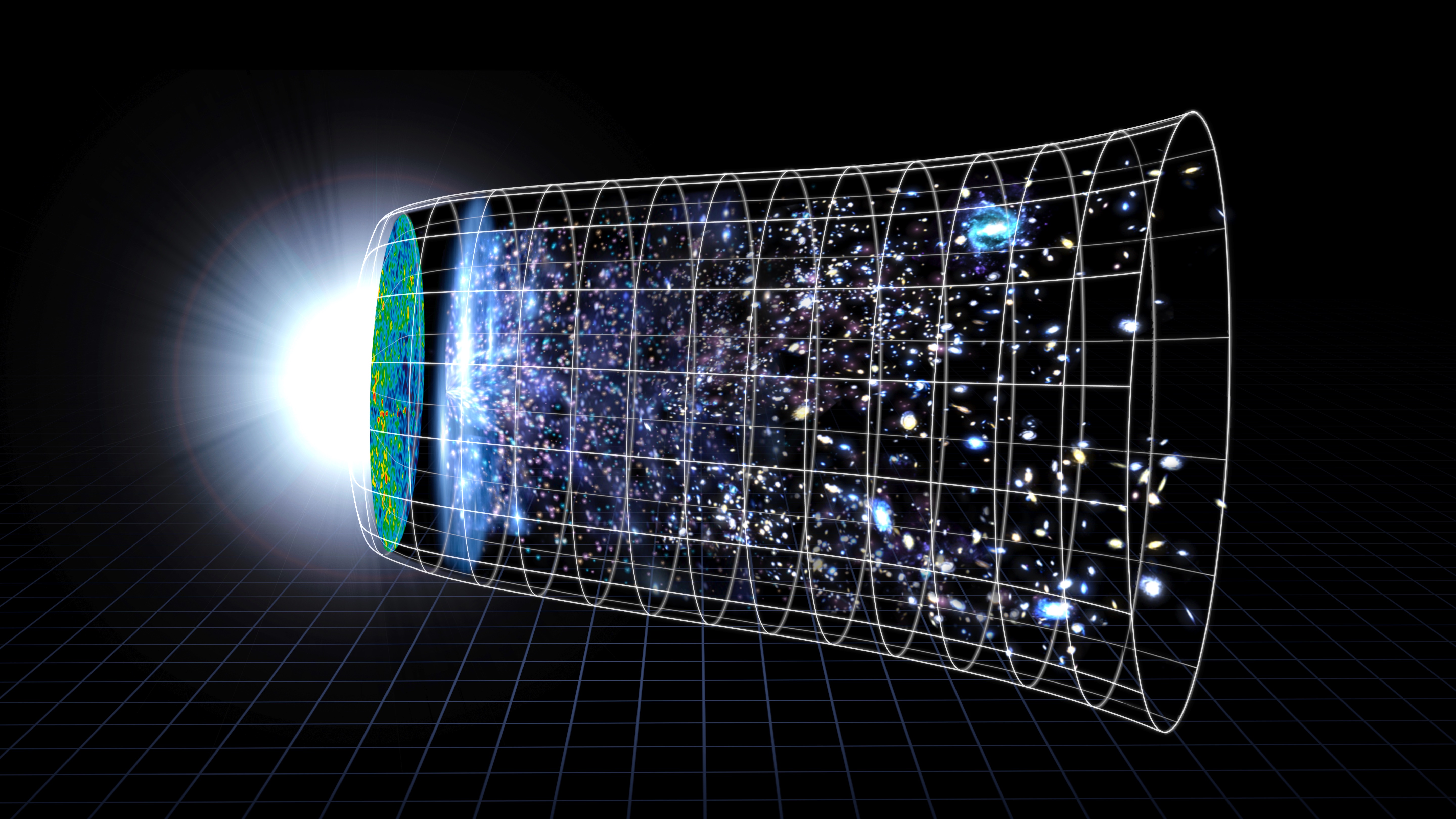 The evolution of the universe over 13.77 billion years © NASA
The evolution of the universe over 13.77 billion years © NASA
It is harder to visualize, but we feel that every point in the universe is part of that growth, and the growth is happening from every point. At the same time, that reminds us that nowhere is special — nowhere is at the beginning or middle of it; it has been going from everywhere. That is the thing I try to get across to push against the idea that it was some central explosion.
Editor’s note: This article has been faithfully transcribed from the original interview filmed with the author, and carefully edited and proofread. Edit date: 2025
Discover more about
the origins of the universe
Dunkley, J. (2019). Our universe: An astronomer’s guide. Pelican Books
Blandford, R., Dunkley, J., Frenk, C., Lahav, O., & Shapley, A. (2020). Coming of age of the standard model. Nature Astronomy, 4, 122–123.
Komatsu, E., Dunkley, J., Nolta, M. R., Bennett, C. L., Gold, B., Hinshaw, G.et al. (2008). Five-Year Wilkinson Microwave Anisotropy Probe (WMAP) Observations: Cosmological Interpretation. The Astrophysical Journal Supplement Series 180:330-376
Einstein, A. (1916). Die Grundlage der allgemeinen Relativitätstheorie. Annalen der Physik IV. Folge.49